What does "Bio-Mimetic" mean as it applies to dentistry?
Bio means "life". Mimic means to "copy". Biomimetic means to copy life-like properties.
So in dentistry, biomimetic means to copy the life-like properties of teeth.
But Biomimetic Dentistry is more than white fillings and cosmetic dentistry. It's about technique-sensitive "Bonding" protocols which retain sound tooth structure while preserving tooth vitality. See the question "I have some white fillings..." below.
Is Biomimetic Dentistry new?
Biomimetic Dentistry is new in the mainstream but it is not new.
More than 25 years of research in adhesive techniques in the mouth combined with intensive review by Dr. David Alleman and subsequent clinical application of technique are the building blocks which make Biomimetic Dentistry the new paradigm.
Many dentists are unaware of these advances but cutting edge dentists and informed patients are changing the paradigm.
How does "Biomimetic Bonding" differ from conventional tooth restoration? Both amalgam and composite-resin...
Fillings leak around the edges. Teeth break around large fillings. White fillings can shrink resulting in failure. Metal and porcelain crowns concentrate force at the edges and break the teeth and/or cause leakage.
Likewise, composite-resin (white fillings) have an average lifespan of 4-6 years. Over time, they shrink and this leakage allows bacteria to infiltrate the tooth and promote decay.
Biomimetic Dentistry addresses this by restoring teeth such that strong portions remain strong, flexible portions remain flexible and bacteria cannot infiltrate the restoration's margins.
When was amalgam invented? Isn't amalgam the right way to do fillings?
There are indications that dental amalgam was used in the first part of the T'ang Dynasty in China... approximately in the 600's AD. In 1833 the Crawcour brothers, two Frenchmen, brought their version of dental amalgam to the United States.
In 1844 it was reported that fifty percent of all dental restorations placed in upstate New York consisted of amalgam. However, at that point the use of dental amalgam was declared to be malpractice, and the American Society of Dental Surgeons (ASDS), the only US dental association at the time, forced all of its members to sign a pledge to abstain from using the mercury fillings. This was the beginning of what is known as the first dental amalgam war.
The American Dental Association was founded in 1859 (replacing the ASDS which folded), and has since strongly defended dental amalgam from allegations of being too risky from a health standpoint.
In 1896, G.V. Black arrived at a dental amalgam formula (and further dental restorative techniques) which ended the amalgam wars. That formula and those techniques are still in use today.
Amalgams may be cheap and easy to place, and their use today is about ½ of all restorations being placed annually. Composite resins (white fillings) comprise the other half.
The Biomimetic disclipine combines the use of composite-resin with additonal, newer materials ---AND TECHNIQUES--- which ameliorate the shortcomings of both of these treatment modalities.
I have some white fillings. Is there a difference between this and biomimetic dentistry?
Yes.
White fillings are a composite resin material which is bonded to the tooth. As this material "cures", it often shrinks. This means the resin/tooth bonded surfaces seperate and leave paths for bacteria to infiltrate the tooth and continue the process of decay--- from the inside.
With newer additional materials and clinically proven scientific techniques, Biomimetic Dentistry prevents this leakage from occuring. Bacteria are sealed out and the tooth's vitality is maintained.
Some dentists call white fillings "White Amalgams". Unless biomimetic procedures are followed, they're effectively the same as amalgam restorations. And, given their shorter service life, they may be even worse.
What do you mean by "Biomimetic Dentistry values the life of tooth structure over the life of the restoration"?
If a cavity were restored with amalgam by merely removing the decay and plopping in the amalgam material, the filling would soon pop out. In order to stay in place, healthy tooth structure is "excavated", usually in the form of a dovetail joint, so that the filling will remain in place.
This is a good technique to keep the filling in place, but at a cost to the tooth and oral health. As these restorations fail over time (due to leakage in the filling/tooth margin or interface), you get more decay and even cracked teeth. This means removing the old filling, removing more healthy tooth structure to afford the necessary "mechanical restorative shape", and placing another amalgam. (You can see where this is going!)
So, the filling stays in place, but at a high price to your tooth's future.
Biomimetic Dentistry honors your healthy tooth structure. If a biomimetic restoration fails, it fails safely so that healthy tooth structure remains and only the restorative material needs replacement. This means your healthy tooth structure is preserved.
How do I know that my practitioner is actually doing Biomimetic Dentistry? What questions should I ask prior to undergoing or agreeing to treatment??
Ask the dentist to summarize the technique. Biomimetic restorations take time. If it takes 30 minutes for 4 teeth, for instance, it's not a biomimetic restoration. For a very large, multiple surface restoration on a single tooth, the time might be closer to one hour.
Further, biomimetic bonding needs to be done with an absolutely dry tooth. A rubber dam, an Isolite, or lots of frequently changed cotton rolls would be required.
Do you still need to use a drill? What is Air Abrasion?
Dental drills are and have been an important apparatus in treating dental decay and are sometimes indicated for full or partial treatment. With that, there are new devices which make the use of a drill much less needed. With their use, they are much less invasive.
One such device uses technology called "Air Abrasion". Think of Air Abrasion as a sand blaster or powerwasher. While the material used in Air Abrasion feels like talcum powder on your fingers, it actually contains microscopic abrasive particles which "blast" away decayed material while preserving healthy tooth structure. So, instead of the drilling sound you're used to, you instead hear the mild sound of compressed air or helium. The use of Air Abrasion also often times means no need for Novocaine injections to numb the tooth.
Many patients are surprised when a dental procedure is begun without the normal Novocaine injection. And, they walk out without that "fat lip" feeling!
View a video with Dr. Michel Haynie explaining Air Abrasion.
What do you mean by rigid and flexible portions of teeth? Aren't teeth solid?
You may think so, but teeth have differing hardness in their anatomy.
Dental enamel is the hardest substance in the human body. With a composition of 96% minerals, it measures a "5" on Mohs scale of hardness... that equivalent to Zirconium.
Dentin, (the next layer of tooth material), measures at 3 on Mohs scale... that equivalent to copper. As you probably know, copper is a soft, bendable and malleable material. Those characteristics make it easy to use in house wiring. So, combining these two, enamel would be rigid and dentin flexible.
Beneath that would be pulp... the soft and blood-rich portion of the tooth containing the dental nerves. And outside the root of the tooth is the material known as Cementum. Cementun is a specialized calcified substance covering the root of a tooth, which is slightly softer than dentin.
Teeth are anything but solid! image courtesy of wikipedia
image courtesy of wikipedia
I've always been told that chewing gum is bad for your teeth. Now I'm hearing that chewing gum is GOOD for your teeth. Can you explain this?
Chewing gum which contains sugar will not help your teeth. Sugars are broken down by bacteria and create acids which attack your teeth.
However, some chewing gums use Xylitol as a sweetener. Xylitol is a natural sweetener which not only starves bacteria of sugars but reportedly contributes to good oral health. Look for chewing gum which uses Xylitol. You can also purchase Xylitol in other forms to help maintain the health of your teeth.
My teeth are super sensitive. Can you talk more about this?
When the tooth's enamel wears down, cavities infiltrate the dentin or gums recede, tiny microscopic tubes located in the dentin or the softer cementum beneath the gingiva (gums) are exposed. Tooth sensitivity is caused by the stimulation of cells within these tubes, causing a short, sharp pain when the area is exposed to hot or cold temperatures through food and beverages- or even by air.
Biomimetic Dentistry addresses this with materials and techniques that completely seal the area of the restoration. Good oral hygiene at home and regular visits to your hygienist will keep your gums healthy, protecting the root.
Remember the joke about the guy coming back from the dentist: He said... "My teeth are fine. The gums have to come out!" Brush, Floss and see your dentist regularly.
You said "Over the lifetime of a single tooth, you can save thousands of dollars." Does that mean I pay more now? How much more expensive is it? Does it take longer? Do dental plans cover it?
Using conventional dentistry, if the lifetime cost of a tooth is US $2,800 [2014 dollars] before treatments like root canals, crowns, extractions, bridges or implants become necessary, and you then count how many teeth you have that have had amalgam fillings, you can see how expensive this will get. Using Biomimetic Dentistry, most of these procedures can be avoided.
Biomimetic Dentistry costs a little more than conventional dentistry because it uses advanced materials and is both technique and time sensitive, requiring more highly trained dentists and more time in the dental chair. Your dentist will work with you and your dental plan provider to get you the best coverage possible. But this is far better than living with the old paradigm and shelling out that $2,800 per tooth over your lifetime.
Biomimetic Dentistry is at the tipping point is getting official recognition by organizations like the ADA and dental plan providers so that your plan coverage goes further, you stay more healthy and EVERYONE saves money.
I was told by my dentist that I need a crown. Doesn't that mean I NEED a crown?
Not necessarily.
It's been said "When you have a hammer, everything looks like a nail."
When all a practioner knows how to do is cut away healthy tooth structure to solve a problem, then that's when you get a crown. Using biomimetic techniques, a great deal of the time, a tooth can be restored without the need for a crown. This saves you a lot of money and preserves natural tooth structure. You don't need to cut down a tooth to a stump to fit the crown and your mouth is happier!
Here's something from buzzle on the topic of crowns:
"Dental crowns are rigid metals and do not flex under pressure generated due to biting. Natural teeth have the property of flexing with biting pressure, and this sometimes disturbs the bonding between the crown and tooth. Plaque and toxins find their way through the loose bond and gain access under the tooth, causing decay. This issue is dealt with under biomimetic [principles], wherein, researchers have developed crown alternatives that mimic natural tooth flexing property. The procedures used are good for tooth restoration."
Credits: © http://www.buzzle.com/articles/is-there-an-alternative-to-dental-crown.html
What is LEAT?
LEAT stands for "Least Expensive Alternative Treatment".
Certain health insurance plans, most commonly dental plans, may include a least expensive alternative treatment (LEAT) clause, which limits the kinds of procedures the plan will cover for a given medical condition.
Specifically, in situations when there are multiple treatment alternatives for a covered condition, plans with LEAT clauses will only cover the cost of the least expensive treatment option, even if other options may have superior long-term outcomes.
In certain cases, LEAT plans will provide some level of benefits if a patient receives a more expensive treatment option, commonly the maximum amount of benefits for the LEAT procedure.
All of the insurance plans most dentists have ever worked with have this limitation in some form or another. The bottom line here is that, if there is more than one way to correct a problem with a tooth, the insurance plan will only pay or "allow costs" for the least expensive option. This is not necessarily what is best for you or necessarily what you may want in your mouth. For example, if you need a filling in a tooth, the least cost alternative might be an amalgam (or silver) filling. While that may have been the acceptable treatment decades ago, due to advances in dentistry and what we know about amalgam, many offices in the US and abroad no longer perform amalgam fillings.
Another example might call for a crown as a least cost alternative versus an onlay. In many cases, an onlay is the best treatment for the patient as there is less "amputation" of natural tooth structure. When you are presented with a treatment plan, you should look for these limitations in your coverage, and consider the short and long term costs for both options so you may choose what is best for you.
Don't crowns prevent cavities?
Absolutely not!
Crowns are used to replace any diseased tooth structure. As a function of the prep, healthy tooth structure must also be removed.
Crowned teeth are destined to fail. Bio-mechanically, crowns don't make sense. Biomimetic dentistry understands how this happens. Natural teeth are designed to flex under biting pressure. Porcelain or gold crowns wrap what remains of the healthy but cut-down tooth structure from the gum-line to the biting surface with an inflexible material.
When you bite your teeth together, the tooth wants to flex but the crown does not. So every time you bite, tension causes the seal between the tooth and crown to weaken and break down. With a good seal now lost, bacteria can get between the tooth and crown. This causes recurrent decay.
Crowns are temporary solutions which hide the inevitable forthcoming decay. Crowns don't prevent cavities. They encourage them! With a crown, you're just creating a new path for bacteria to enter the tooth and continue the process of decay.
Brushing and flossing are important but you can't brush underneath a crown.
And while you can't get in there... decay-causing bacteria can (and will).
Can you compare conventional treatment with Biomimetic treatment using crowns as an example?
Here's a side-by-side example:Conventional
TreatmentBiomimetic
Treatment
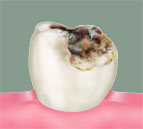
The tooth has decay. 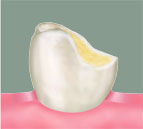
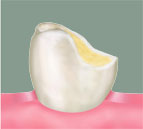
The decay is removed with a drill. The decay is removed initially with a drill and then finely finished using a less invasive instrument like Air Abrasion. This is dependent upon your practitioner's assessment. 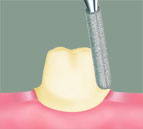
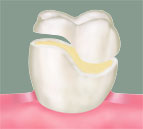
The tooth is now drilled down even further, even removing healthy tooth structure, to allow for the placement of a crown. Limited tooth structure is removed. Healthy tooth structure remains intact. Structural strength of the tooth is maintained by techniques which replicate natural rigid and flexible portions of tooth anatomy. An inlay or onlay is prepared. 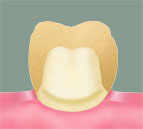
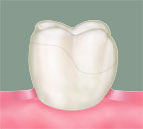
A gold (or porcelain) crown is placed over the remaining "stump" of the tooth. Recurrent decay will occur as bacteria find their way through the restoration's margins and continue the process of decay from the inside. A Root Canal may be in your future. The inlay or onlay is biomimetically bonded to the restoration. Together, they honor and replicate natural oral anatomy. Subsequent bacterial invasion and recurrent decay is prevented because of these biomimetic techniques. Images copyright © Richard Gagne DDS
https://www.dentalsedation.com/pages/biomimetic.html
What is a root canal?
When decay infects a tooth and penetrates the dentin, the next place for it to go is the dental pulp chamber.
The pulp chamber is the heart and brain of the tooth and provides the needed blood flow to keep the tooth healthy. When decay reaches this area, it's usually the beginning of the end of a tooth's life.
In root canal therapy (endodontic treatment), the infected pulp is removed, the root "canals" are disinfected and a filler material called "gutta percha" is carefully inserted to fill the voids. Technically, the tooth is now dead.
A brief video demonstrates the root canal procedure. Note how much healthy tooth structure is removed in the process!
Biomimetic dentistry is reported to eliminate the future need for root canals (and new crowns!) by 75%.
What role does Ozone play in dentistry?
Ozone mimics a naturally occurring process in the human body.
White blood cells fight bacteria by entering the bacteria creating an oxidative burst that punctures the bacterial cell wall and cripples the harmful organisms – Ozone does the same.
As more ozone attacks the bacteria, thousands of holes are created in the cell wall. Within seconds, the bacterial cell wall can no longer hold its shape. The cell wall collapses and the damaging cell dies. By saturating the tooth nerve, the ozone penetrates into the micropores and safely kills virtually all harmful bacteria.
Ozone is considered by medical professionals as one of the safest therapies. Ozone disinfects 3,000 times better than bleach chlorine or other disinfecting chemicals with virtually no side-effects. Ozone is so safe it has been approved by the FDA for the sanitization of meats, poultry, fruits and vegetables.
© 2012 Doueck Dental. www.doueckdental.com All rights reserved.
What Is Vital Pulp Therapy?
Vital Pulp Therapy (VPT) is the treatment of a tooth in which the health or vitality of the dental pulp is addressed with techniques which aim to keep it vital. This differs from root canal treatment in which the pulp, the living part of the tooth, is completely removed and the tooth is dead.
With Root Canal Therapy, the treated tooth is left as a shell of its former self... lacking nerves and blood supply.
Root Canal Therapy is performed usually under two circumstances.
1. The pulp has become infected, an abscess has developed or pain associated with the tooth indicates its upcoming demise.
2. Decay has progressed to the point that the pulp may soon become involved and, lacking the techniques or ability to maintain its vitality, the practitioner decides it's just easier to do a Root Canal now rather than wait for full involvement.
Practitioners trained in Vital Pulp Therapy can address the latter circumstance by a process called "Pulp Capping". Infected dentin is removed to the point where the pulp is not exposed. Remaining bacteria is deactivated and the pulp chamber is sealed. This is called "Indirect Pulp Capping".
"Direct Pulp Capping" (where the vital pulp is exposed) is sometimes used but has triple the failure rate of the "Indirect" approach as it applies to future endodontic intervention. *
With the pulp chamber protected, a minimally invasive bonded restoration can be performed to bring the tooth back to a healthy, functional state.
When Vital Pulp Therapy is indicated and available, your tooth remains alive & healthy and Root Canal treatment is avoided.
*(Alleman/Magne - 2012 http://www.ncbi.nlm.nih.gov/pubmed/22299120 )
Is Biomimetic Dentistry only for adults? What does it mean for kids?
On our "For Patients" page, there is an excerpt which speaks to lifetime dental costs.
If children are treated Biomimetically, they will likely not have to go through the invasive procedures their parents have experienced. Further, with Air Abrasion, children don't grow up with fear of going to the dentist.
That makes them partners with their dentist in addressing their own oral health and provides an excellent prognosis for their mouths in adulthood.
So yes... Biomimetic Dentistry is MOST APPROPRIATE for children.
What dental schools are teaching biomimetic dentistry? I understand that some dental schools are even teaching this and stopping the curriculum involving the use of crowns. Is this true?
- In the United States at the USC School of Dentistry, Biomimetic Dentistry is not optional but rather, a part of their embedded curriculum. UMDNJ, Loma Linda Univ, The Univ of Iowa, The University of Pennsylvania and NYU are all now including curricula for minimally invasive restorative dentistry.
- In Europe, The Univ of Geneva - Switzerland, Nijmegen Univ - Netherlands and Catholic Univ of Leuven - Beligum are all offering the same.
- The Univ of Geneva, Switzerland teaches only replacing existing crowns with new ones. Barring a replacement, they use adhesive inlays an onlays for restoring broken down teeth when a crown would otherwise be the conventional treatment. USC is going steadily in this direction as well.
I hear cavities are on the increase due to the popularity of bottled water. Is this true?
There are several issues regarding bottled water.
One is Fluoride. Studies have shown that municipalities that add fluoride to drinking water experience a significantly lower incidence of tooth decay in their populations. Brushing with a fluoride toothpaste can make sure your teeth receive the protection fluoride affords.
Another issue is pH. pH is a measure of the acidity or basicity of an aqueous solution. 7 is neutral, lower is acidic and higher is called basic or alkaline. Pure water has a pH very close to 7. If your brand of bottled water has a pH lower than 7, it is creating an acidic environment in your mouth which bacteria enjoy. Choosing a brand with a neutral pH (or even slightly basic) will help your body's natural processes maintain better control of decay causing acid.
So, if I have my teeth restored biomimetically, does this mean I don't need to go to the dentist anymore?
Don't even go there!
It is important to see your dentist regularly. Checkups allow your dentist and hygienist to evaluate your mouth and find & correct any problems in their early stages. While biomimetic dentistry and its minimally invasive techniques prevent the loss of healthy tooth structure in restorative procedures, regular evaluations and cleanings can eliminate the need for those procedures and keep your mouth in good health. Think of it as "preventive care"... like maintaining your car or seeing your doctor for annual physicals.
We've seen reports that a mere 20% of patients use their full dental plan benefits annually. If you use those benefits preventively, then with regular care, there will be much less need to use them on extensive (and expensive) procedures.
The best advice is to talk with your (Biomimetic) dental provider and ask them to contact you to schedule regular dental checkups every 6 months. As has been said... "An ounce of prevention is worth a pound of cure!"
Testimonials:
Every tooth in a man's head is more valuable than a diamond.
- Miguel de Cervantes, Don Quixote, 1605
The best and cheapest dentistry is when the right thing is done extremely well the first time. And it lasts.
CrystalAir Air Abrasion
No more drilling! Ask your dentist about the CrystalAir Air Abrasion system.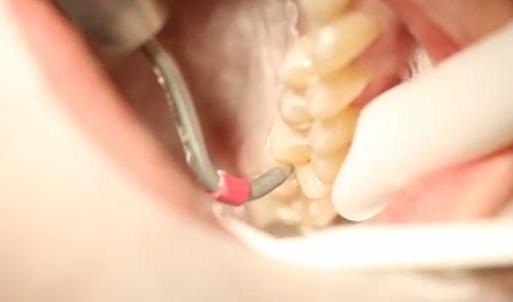
Zellies.com
Protect your oral health with Xylitol. Learn more at Zellies.com
What does "Bio-Mimetic" mean as it applies to dentistry?
Is Biomimetic Dentistry new?
How does "Biomimetic Bonding" differ from conventional tooth restoration? Both amalgam and composite-resin...
When was amalgam invented? Isn't amalgam the right way to do fillings?
I have some white fillings. Is there a difference between this and biomimetic dentistry?
What do you mean by "Biomimetic Dentistry values the life of tooth structure over the life of the restoration"?
How do I know that my practitioner is actually doing Biomimetic Dentistry? What questions should I ask prior to undergoing or agreeing to treatment??
Do you still need to use a drill? What is Air Abrasion?
What do you mean by rigid and flexible portions of teeth? Aren't teeth solid?
I've always been told that chewing gum is bad for your teeth. Now I'm hearing that chewing gum is GOOD for your teeth. Can you explain this?
My teeth are super sensitive. Can you talk more about this?
You said "Over the lifetime of a single tooth, you can save thousands of dollars." Does that mean I pay more now? How much more expensive is it? Does it take longer? Do dental plans cover it?
I was told by my dentist that I need a crown. Doesn't that mean I NEED a crown?
What is LEAT?
Don't crowns prevent cavities?
Can you compare conventional treatment with Biomimetic treatment using crowns as an example?
What is a root canal?
What role does Ozone play in dentistry?
What Is Vital Pulp Therapy?
Is Biomimetic Dentistry only for adults? What does it mean for kids?
What dental schools are teaching biomimetic dentistry? I understand that some dental schools are even teaching this and stopping the curriculum involving the use of crowns. Is this true?
I hear cavities are on the increase due to the popularity of bottled water. Is this true?
So, if I have my teeth restored biomimetically, does this mean I don't need to go to the dentist anymore?
